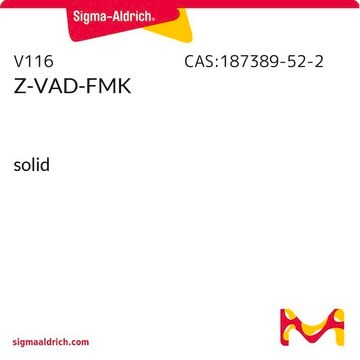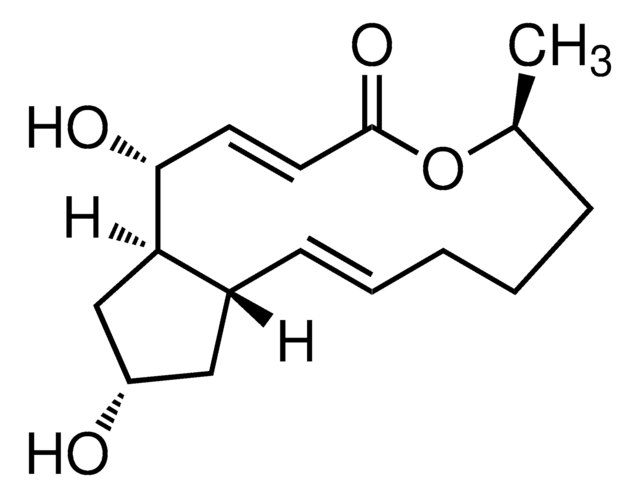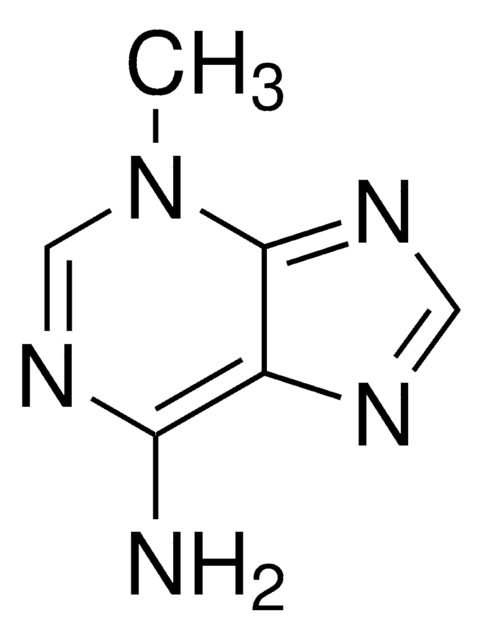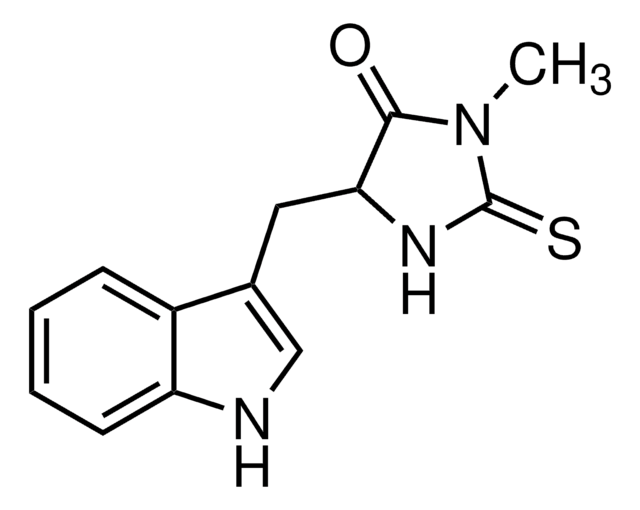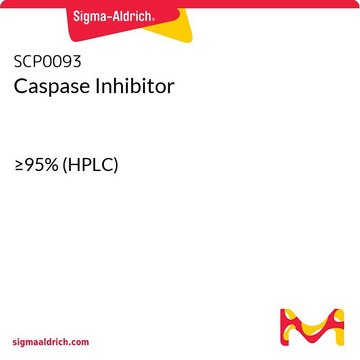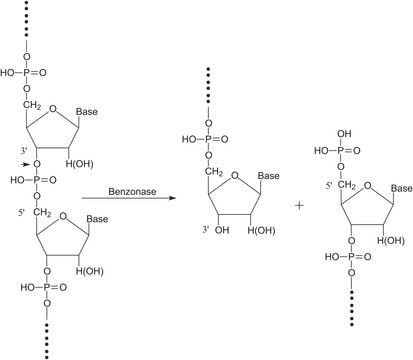235420
Caspase-3 Inhibitor I
The Caspase-3 Inhibitor I, also referenced under CAS 169332-60-9, controls the biological activity of Caspase-3. This small molecule/inhibitor is primarily used for Cancer applications.
别名:
Caspase-3 Inhibitor I, CPP32/Apopain Inhibitor, Ac-DEVD-CHO
登录查看公司和协议定价
所有图片(1)
About This Item
推荐产品
品質等級
化驗
≥90% (HPLC)
形狀
solid
製造商/商標名
Calbiochem®
儲存條件
OK to freeze
顏色
white
溶解度
DMSO: 5 mg/mL
water: soluble
運輸包裝
ambient
儲存溫度
−20°C
SMILES 字串
N([C@@H](C(C)C)C(=O)N[C@@H](CC(=O)O)C=O)C(=O)[C@@H](NC(=O)[C@@H](NC(=O)C)CC(=O)O)CCC(=O)O
InChI
1S/C20H30N4O11/c1-9(2)17(20(35)22-11(8-25)6-15(29)30)24-18(33)12(4-5-14(27)28)23-19(34)13(7-16(31)32)21-10(3)26/h8-9,11-13,17H,4-7H2,1-3H3,(H,21,26)(H,22,35)(H,23,34)(H,24,33)(H,27,28)(H,29,30)(H,31,32)/t11-,12-,13-,17-/m0/s1
InChI 密鑰
UMBVAPCONCILTL-MRHIQRDNSA-N
一般說明
A specific and reversible inhibitor of CPP32/Apopain/Yama (IC50 = 0.2 nM). A member of the ICE/CED-3 family of cysteine proteases, which are important in apoptosis.
A very potent, specific, and reversible inhibitor of caspase-3 (IC50 = 200 pM), caspase-6, caspase-7, caspase-8, and caspase-10.
生化/生理作用
Cell permeable: no
Primary Target
Capase-3, capase-6, capase-7, capase-8, capase-10
Capase-3, capase-6, capase-7, capase-8, capase-10
Product does not compete with ATP.
Reversible: yes
Target IC50: 200 pM against caspase-3
包裝
Yes
警告
Toxicity: Standard Handling (A)
序列
Ac-Asp-Glu-Val-Asp-CHO
重構
Following reconstitution, aliquot and freeze (-20°C). Stock solutions are stable for up to 3 months at -20°C.
其他說明
Garcia-Calvo, M., et al. 1998. J. Biol. Chem. 273, 32608.
Thornberry, N.A., and Lazebnik, Y. 1998. Science 281, 1312.
Nicholson, D.W. 1996. Nature Biotech. 14, 297.
Schlegel, J., et al. 1996. J. Biol. Chem. 271, 1841.
Nicholson, D.W., et al. 1995. Nature376, 37.
Thornberry, N.A., and Lazebnik, Y. 1998. Science 281, 1312.
Nicholson, D.W. 1996. Nature Biotech. 14, 297.
Schlegel, J., et al. 1996. J. Biol. Chem. 271, 1841.
Nicholson, D.W., et al. 1995. Nature376, 37.
法律資訊
CALBIOCHEM is a registered trademark of Merck KGaA, Darmstadt, Germany
儲存類別代碼
11 - Combustible Solids
水污染物質分類(WGK)
WGK 3
閃點(°F)
Not applicable
閃點(°C)
Not applicable
Ole Ladefoged et al.
Basic & clinical pharmacology & toxicology, 94(4), 169-176 (2004-04-14)
Pregnant Wistar rats were exposed to 1500 ppm toluene 6 hr/day from gestational day 7-20 or to chronical mild stress from gestational day 9-20 as single exposure or in combination. Behavioural, immunohistopathological, molecular biological, and neurochemical methods were applied to
Xiaotong Lou et al.
Oxidative medicine and cellular longevity, 2021, 9397960-9397960 (2021-09-24)
In glaucomatous eyes, the main aqueous humor (AH) outflow pathway is damaged by accumulated oxidative stress arising from the microenvironment, vascular dysregulation, and aging, which results in increased outflow resistance and ocular hypertension. Schlemm's canal (SC) serves as the final
Gurdeep Marwarha et al.
Biomedicines, 10(1) (2022-01-22)
Apoptotic cell death of cardiomyocytes is a characteristic hallmark of ischemia-reperfusion (I/R) injury. The master hypoxamiR, microRNA-210 (miR-210), is considered the primary driver of the cellular response to hypoxic stress. However, to date, no consensus has emerged with regards to
Evelina Valionyte et al.
Cell death and differentiation (2021-12-05)
SQSTM1/p62, as a major autophagy receptor, forms droplets that are critical for cargo recognition, nucleation, and clearance. p62 droplets also function as liquid assembly platforms to allow the formation of autophagosomes at their surfaces. It is unknown how p62-droplet formation
我们的科学家团队拥有各种研究领域经验,包括生命科学、材料科学、化学合成、色谱、分析及许多其他领域.
联系技术服务部门